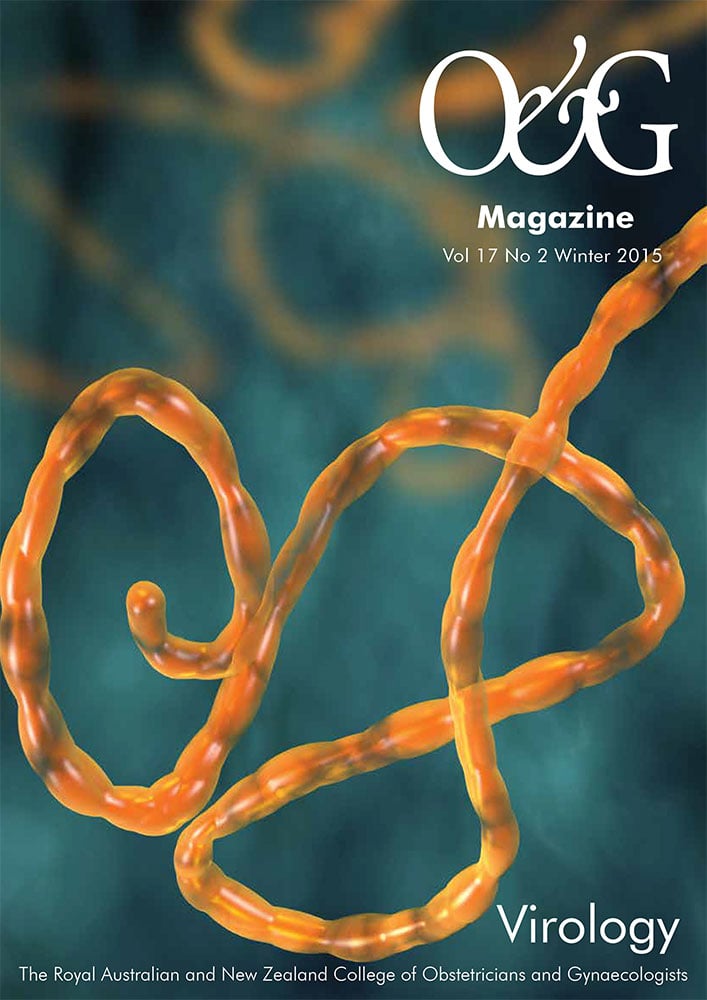Since 1991, Australia has had an organised approach to preventing cervical cancer. The National Cervical Screening Program (NCSP), using a Pap smear every two years in women aged 18–69, has resulted in a 50 per cent reduction in the incidence and mortality of this disease. In 2010, there were 818 new cases of cervical cancer in Australia and, in 2011, there were 229 deaths from this disease. The two-year participation rate for cervical screening in Australia is about 56 per cent and 80 per cent of Australian women will have had a Pap smear by five years. About 80 per cent of all new cases of cervical cancer arise in women who are under-screened or have never been screened. Cervical cancer is now the third commonest gynaecological cancer (behind endometrium and ovary) in Australian women and virtually all cases are caused by human papilloma virus (HPV) infection.
HPV causes cancer
In 1982, Harald zur Hausen demonstrated that HPV was the cause of cervical cancer. HPVs are DNA viruses that infect cutaneous or mucosal epithelium. There are more than 130 types of HPV of which 40 infect genital tract mucosa. They are classified into low- and high-risk types based on clinical outcome. Low-risk types cause benign anogenital warts and, of these, HPV 6 and 11 cause over 90 per cent of anogenital warts and recurrent respiratory papillomatosis. Infection with high-risk types cause virtually 100 per cent of cervical cancer, 90 per cent of anal cancers, 50 per cent of vulvar, vaginal and penile cancers, and 12 per cent of oropharyngeal cancers. HPV types 16 and 18 cause about 70 per cent of cervical cancers and HPV types 16, 18, 45, 31, 33, 52, 58 and 35 cause approximately 95 per cent of cervical cancers.
In most cases of HPV infection, the viral DNA is separated from the host genome as an episome (productive infection). However, when malignant transformation occurs the viral DNA is integrated into the host genome and there is expression of early proteins E6 and E7, which inactivate the tumour-suppressor genes p53 and retinoblastoma protein, respectively, allowing uncontrolled cell growth and carcinogenesis to occur. Preventing oncogenic HPV infection in women will prevent the development of cervical cancer, hence the recent introduction of a HPV vaccination program in Australia.
The vaccine
HPV cannot be grown in the laboratory, making the development of a live attenuated or killed vaccine impossible. Breakthrough research (Ian Frazer and his team) led to the development of ‘virus like particles’ (VLP) and subsequent development of a quadrivalent vaccine against HPV types 6,11, 16 and 18 (Gardasil) and a bivalent vaccine against types 16 and 18 (Cervarix). The HPV L1 capsid protein is the antigen in both vaccines and is produced by recombinant techniques. These proteins assemble themselves as VLPs identical to HPV virions, but with no DNA core.
Efficacy and immunogenicity studies showed Gardasil to be highly effective in preventing genital warts and both Gardasil and Cervarix almost 100 per cent effective in preventing HPV 16-18-related high-grade squamous abnormalities of the cervix (CIN2-3). Vaccination is highly immunogenic, generating high concentrations of neutralising antibodies to L1, and ongoing studies suggest protection for at least eight-to-ten years, with stable antibody titres strongly suggesting long-term protection.
The program
In 2007, a population-based National HPV Vaccination Program (NHVP) commenced in Australia. Gardasil was the only registered HPV vaccine in Australia at that time and was endorsed for use in the fully funded national program. This program aimed to deliver vaccine (three doses) to girls in school aged 12–13, a two-year catch up program for 13–18 year old girls through schools and a two-year catch up program for women aged 18–26 through GPs and community-based programs. The catch-up programs finished in 2009. A National HPV Vaccination Program Register (NHVPR) commenced in 2008. In 2013, a male program was commenced (12–13-year-old boys in school) with a catch up program for 14–15 year olds until the end of 2014.
School-based vaccination
There is strong evidence in Australia for school-based vaccination being the optimal method of delivery for adolescents. Initial coverage data showed that 70.7 per cent of girls who were 15 years of age in 2009 had received three doses of the vaccine and this level of coverage has been maintained. Catch up coverage data suggested good uptake for girls 14–17, but lower coverage rates for women aged 18–26 years. Under-notification to the HPV register of doses given to adult women in general practice means that the coverage estimates for older women are 5–15 per cent underestimated.
HPV vaccination safety
Adverse events following immunisation are notified to the Therapeutic Goods Administration that maintains a database. Local injection site reactions, nausea and fever are the most common symptoms notified as adverse reactions after vaccination. Syncope has also been documented following vaccination, but this is relatively common in the target age group following vaccination and is not attributable to the HPV vaccine per se but to the injection process itself. Anaphylaxis has been rarely reported and all recipients should be observed for 15 minutes post injection. The international safety experience with HPV vaccines is now extensive, with over 210 million doses of HPV vaccines distributed globally, and the WHO Global Advisory Committee on Vaccine Safety having reviewed the vaccine regularly with no concerns raised. There is no association between vaccination and the occurrence of autoimmune, neurological or thromboembolic events.
Impact on disease incidence
This is a good news story with significant impact on disease prevalence within five years of starting the vaccination program. There has been a demonstrated dramatic fall in the prevalence of HPV vaccine types (6, 11, 16, 18) in women aged 18–24 years following the introduction of the program and some evidence of herd immunity. There is also some evidence of some cross protection for related HPV types 31 and 33.
There has been a significant fall in the detection rate of histologically confirmed high-grade cervical abnormalities and high-grade cytology in young vaccinated women compared with unvaccinated women. Eventually this will translate into reduced incidence and mortality from cervical cancer in vaccinated women.
There has also been a significant and marked decline in the incidence of genital warts in both females (vaccinated) and in males (herd immunity) as recorded by public sexual health services since the introduction of HPV vaccination in 2007. National hospital data has also shown a significant reduction in hospital admissions for genital wart-related treatments, in males and females, especially in the younger age groups and is the first evidence we have of an equal impact on disease burden among Indigenous Australians.
Participation
Coverage data available from the NHVPR shows an overall three dose completion rate of over 70 per cent of girls aged 12–13, with indications that this is rising further in the recent vaccination cohorts (75 per cent in 2012). Such coverage data are important and analysis provides information about who is being vaccinated and who is not, and this allows an investigation as to why not. Physician endorsement of vaccine usage is important as is a positive family vaccine attitude, but safety and cost are concerns for some along with a lack of knowledge about HPV and cervical cancer and how their daughter could possibly be at risk.
There have been concerns that vaccinated women would no longer see a need to participate in cervical screening. A recent Australian publication has shown a ten per cent fall in screening rates in vaccinated women aged 20–24, and 13 per cent in women aged 25–30. This is worrying and highlights the need for continuing education in this area.
The future of HPV vaccination
In 2014, the WHO approved the use of two-dose HPV vaccine schedules for those aged <15 years of age and some countries have commenced using these reduced dose schedules already (for example, the UK). The approval was based on demonstration of equivalent immunogenicity in this age group when two doses are given spaced at least six months apart (a prime-boost strategy) compared to the standard three-dose schedule (0, 1–2, six months) in older women that has known efficacy. This schedule has not yet been approved for use in Australia.
Australia is moving to a screening program with five-yearly primary HPV testing with partial genotyping (HPV 16-18) and cytology triage for other oncogenic HPV types. This is predicted to reduce the incidence and mortality from cervical cancer by about 22 per cent and the efficiency of this renewed program will depend on the continued high participation levels of women in the HPV vaccination program. All women, vaccinated or not, will need to continue to participate in the screening program as not all oncogenic HPV types are covered by the current vaccine.
A recently developed nine-valent HPV vaccine (Merck) has been shown to be effective and non-inferior to the quadrivalent vaccine (for HPV types 6, 11, 16, 18) and will provide additional protection against HPV types 31, 33, 45, 52 and 58, which are the next five most common HPV types detected in cervical cancers. This new vaccine has been approved by the FDA in the US and will be considered for use in Australia in the near future. If introduced, it has the capacity to prevent more than 90 per cent of cervical cancers and the associated pre-cursor lesions. If such a vaccine can be effectively delivered prior to sexual debut, women may only need to screen once or twice in a lifetime for almost complete protection against cervical cancer.
Conclusion
This is an exciting time for cervical cancer prevention in Australia. In 2017, we will have a new cervical screening program based on primary HPV testing and we already have a trail-blazing national HPV vaccination program.
The government-funded NHVP has been well received in Australia, with over a 70 per cent uptake in the target population. HPV vaccination has been shown to have a dramatic effect on oncogenic HPV prevalence, detection rates of high-grade CIN (histology and cytology), and the incidence of genital warts. The introduction of male vaccination, attempts to improve vaccination coverage in girls and boys, and the possible introduction of a nine-valent vaccine in the not-too-distant future should all lead to further improvements in cervical cancer prevention in Australia.
We must continue to strive for total participation in our screening program and maximal coverage in the HPV vaccination program. If both could be achieved we could conceivably eradicate cervical cancer in Australia. For now, cervical cancer is going, but sadly will not be gone for some time yet.
Further reading
Kahn J, HPV vaccination for the prevention of cervical intraepithelial neoplasia. N Engl J Med 2009,361;3.271-277.
Brotherton JM, Murray SL, Hall MA et at. Human papillomavirus vaccine coverage among female Australian adolescents: success of the school-based approach. Med J Aust. 2013:199;614-617.
Arnheim-Dahlstrom L, Pasternak B, Svanstrom H et al. Autoimmune, neurological, and venous thromboembolic adverse events after immunisation of adolescent girls with quadrivalent human papillomavirus vaccine in Denmark and Sweden: cohort study. BMJ 2013. 347:f5096.
Garland SM. The Australian experience with the Human papillomavirus vaccine. Clin Ther 2014 36(1); 17-23.
Brotherton JM Human papillomavirus vaccination: Where are we now? J Paed Child Health 2014, 50 (12):959-965.
Quadrivalent HPV vaccine, frequently asked questions. www.ncirs.edu.au/immunisation/fact-sheets/hpv-quadrivalent-fact-sheet.pdf (last accessed 17 March 2015).
Human papillomavirus vaccines for Australians; information for immunisation providers. www.ncirs.edu.au/immunisation/fact-sheets/hpv-human-papillomavirus-fact-sheet.pdf (last accessed 17 March 2015).
Acknowledgements
My special thanks to Dr Julia Brotherton, Medical Director of the National HPV Vaccination Program Register, for her constructive review of this article.






Leave a Reply